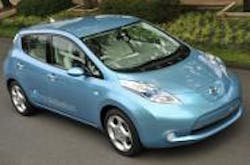“We are committed to making strides to revitalize the American auto industry and supporting the development of clean energy vehicles. This is an investment in our clean energy future. It will bring the U.S. closer to reducing our dependence on foreign oil and help lower carbon pollution.” –U.S. Energy Secretary Steven Chu
I suspect many folks out in the trucking community think the billions in taxpayer funds being dispersed by the Department of Energy (DOE) of late to fund a variety of vehicle-related projects is money being thrown out the window. I mean, let’s face it: we’ve got trillions in public debt being piled up at an astronomical rate (this year’s federal deficit alone is equal to $4,500 for every man, woman and child in the U.S.) so I’m in no way surprised that many feel we oughta turn off the vehicle research funding spigot pretty quick here.
And yet all this money from the DOE – funding everything from the new “SuperTruck” fuel efficiency project to automaker loans for re-tooling factories – could, in the end, be the decisive factor in our nation developing a new generation of cars, light trucks, and commercial vehicles that use far less petroleum and leave us far less exposed to the vagaries of world’s oil markets.
Take the recent $1.4 billion loan agreement DOE just finalized Nissan North America to retool its Smyrna, Tennessee, factory to build electric automobiles and a new EV battery manufacturing facility. Those two projects are expected to create up to 1,300 American jobs and, potentially, conserve up to 65.4 million gallons of gasoline per year if electric vehicles are widely adopted by motorists – an amount equal to six times the oil spilled by the Exxon Valdez in 1989, DOE stressed.
Nissan plans to use the proceeds from the loan to produce its all-electric vehicle, the LEAF (above at right), at its existing Smyrna, Tennessee plant -- eventually offering electric vehicles to fleet and retail customers, and plans to ramp up production capacity in Smyrna up to 150,000 vehicles annually.
In fact, Nissan said it is pursuing a global strategy of transitioning to electric vehicles, with its Smyrna plant expected to produce 200,000 battery packs annually. Nissan is also trying to lay the groundwork in developing an infrastructure in the U.S. to support electric vehicles, forming partnerships with states, counties, municipalities, and electric utilities to prepare markets for the introduction of electric vehicles including the installation of charging stations.
This isn’t the first such EV investment DOE’s made, it should be noted. Last week, DOE also signed a $465 million loan agreement with Tesla Motors – makers of the Model S all-electric roadster -- to build manufacturing facilities in California for electric power-trains and Tesla's slick car (the cool red machine at left) as well. DOE also signed a conditional commitment with Fisker Automotive to build plug-in hybrid electric vehicles and slid Tenneco funding in October last year to support EV technology component manufacturing.
DOE also loaded $5.9 billion to Ford Motor Company in September last year to help transform the automakers factories across Illinois, Kentucky, Michigan, Missouri, and Ohio so it could build more fuel efficient models. That deal is part of Obama Administration’s effort to boost corporate average fuel economy (CAFÉ) standards up to 35.5 miles per gallon in the year 2016; a standard expected to reduce oil consumption by an estimated 1.8 billion barrels, saving motorists some $3,000 a year in average fuel costs, while preventing greenhouse gas emissions of approximately 950 million metric tons annually.
Ford said its using that money to improve the efficiency of light vehicles with technologies to improve internal combustion engines and transmissions, reduce vehicle weight, reduce vehicle drag with more aerodynamic designs, and improve vehicle efficiency through the development of hybrid and plug-in electric vehicles. The loan proceeds will enable Ford to raise the fuel efficiency of more than a dozen popular models, representing close to two million new vehicles annually, and save more than 200 million gallons of gas a year.
Altogether, DOE’s loans to Ford, Tesla, Nissan and others total more than $8 billion – not chump change in my book, at least.
On another front, DOE is shifting nearly $80 million from funds it received through the American Recovery and Reinvestment Act [the big $787 billion “stimulus bill” passed by Congress in Feb. 2009] for research into biofuels research and refueling infrastructure.
Two biofuels consortia – the National Alliance for Advanced Biofuels and Bioproducts (NAABB), with $44 million, led by the Donald Danforth Plant Science Center in St. Louis, Missouri, along with the National Advanced Biofuels Consortium (NABC), with $33.8 million, led by the National Renewable Energy Laboratory and Pacific Northwest National Laboratory – are getting the lion’s share that funding, mainly to research algae-based and other next-generation biofuels.
“Advanced biofuels are crucial to building a clean energy economy,” said Energy Secretary Steven Chu recently (seen here at left).
“By harnessing the power of science and technology, we can bring new biofuels to the market and develop a cleaner and more sustainable transportation sector," he explained. "This investment will help spur the creation of the domestic bio-industry, while creating jobs and reducing our dependence on foreign oil.”
Now, will all of this pay for the U.S. taxpayer, in terms of less fuel consumption and greater energy security? That’s the real trick in all of this. I for one hope it does.
